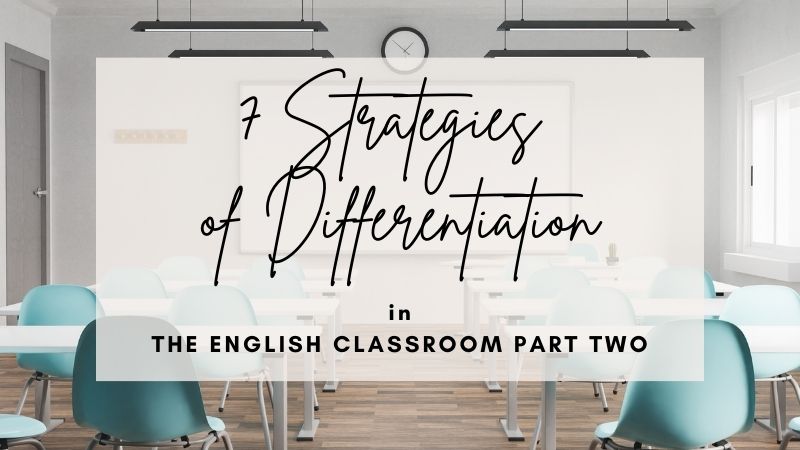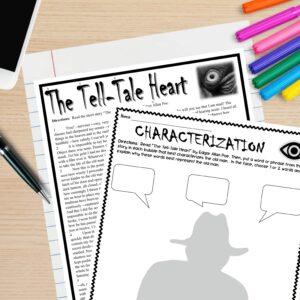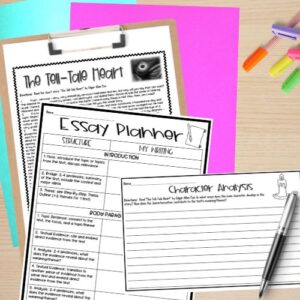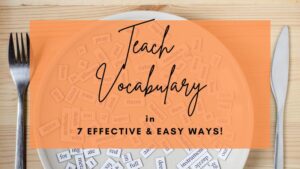Formalized differentiated instruction was established in the 1970s but it existed long before with one-room schoolhouses. We have come a long way from having a single teacher for all students including all grades and subjects! But that doesn’t mean that Strategies of Differentiation within instruction can’t still be a challenge for teachers. If you have a class full of students, it likely sounds daunting to try to figure out how to meet the needs of every student in your classroom! But I’m here to ease your mind and to share some EASY strategies of differentiation that do not take a lot of time and effort but do make a big impact.
This is the second post in a two-part series about creating, practicing, and maintaining strategies of differentiation in a differentiated classroom. Check out part one about class structure and set-up with an emphasis on students as the focus.
Need help with Test Prep and Strategies of Differentiation? Check out this FREE Pack of 3 Test Prep Activities to help students achieve success on standardized tests!
What Differentiated Instruction Is
Differentiated Instruction provides individualized instruction and tools to meet the needs of diverse learners in your classroom. Again, at its most basic, differentiated instruction is doing different things.
Differentiated Instruction does NOT mean creating individual lesson plans for each student in your classroom. It doesn’t mean incorporating individual activities for each student or teaching each student one-on-one each day.
A differentiated classroom is one where the teacher includes approaches, activities, and strategies of differentiation to meet the diverse needs of the learners in his or her English classroom.
7 Strategies of Differentiation in the English Classroom
1. By Reading Passages
When including a specific text such as Edgar Allan Poe’s “The Tell-Tale Heart” you could use the original version. But another option is to use one designed for struggling readers. There are websites such Rewordify.com that can recreate passages based on Lexile levels. You could also shift to another text or provide different options. Think about using “The Tell-Tale Heart” versus “The Masque of the Red Death.”
2. By Reading Assignments
Another way you can use strategies of differentiation is through reading activities. Individual assignments can be modified based on student needs. Here, it is optimal to establish the success criteria for the lesson and figure out how students might best meet those criteria in the time allotted for the task. For some, it will mean more steps, and for others less because of the time constraint.
-
- For example, student A might answer 3 questions about theme, whereas student B answers 5 questions. The additional questions can push students to dig more deeply into making connections or extend their learning.
- Another option is to shift the requirements for supporting evidence in an assignment. Student A might provide 1 piece of evidence to support his or her ideas instead of 2 pieces of evidence.
- A final example is in differentiating the way students might respond. Student A might draw, student B might respond orally, and student C might respond in writing. For each, they will use evidence to support their ideas – the end goal is the same but the task is different.
3. By Writing Activities
If you’re teaching a literary analysis essay like this one for Poe’s “The Tell-Tale Heart,” you can differentiate for any and all learners.
What it looks like in the classroom:
This example of a product for differentiation explains that some students might write a full essay, and others might write a paragraph or a 2-3 sentence response instead.
In this or another assignment, if 4 pieces of evidence are required, then some students might instead include 2 pieces of evidence. If 5 sources are required, then it might shift to 2 or 3 instead to support the content.
Finally, it might mean a more significant shift in the assignment itself. If the assignment is to write a narrative essay, and it’s clear that students in your class would struggle with such an activity then maybe they complete an outline rather than the essay, or they write a narrative poem rather than the essay.
4. By Rubric
A rubric is a ‘living’ document in that it can change to meet the needs of the assignment and the class. In the example above with shifting an assignment’s form, you want to make sure that your rubric clearly identifies the success criteria for the task and that each form – essay, outline, poem – fits the criteria and provides students a chance to be successful in meeting the criteria.
You can add and take away from rubrics. For example, a differentiated rubric might mean including only 1-2 skills for struggling writers.
Another way to make this more specific to the learners in your class without making 30+ different rubrics is to have students create their rubrics. In this way, students can reflect and review the skills they need to further develop and focus on those skills for a particular assignment.
5. By Extension Activities
When a student is done with her or his work, we can provide differentiated games, puzzles, and creative writing prompts. This strategy, like other strategies of differentiation, doesn’t mean adding busy work but rather extending their thinking and learning beyond the lesson.
If the lesson was about a particular poem, you could extend learning through strategies of differentiation by using this bundle of Boom cards with questions/quizzes about different poems.
If you’re in a unit on satire, then you could encourage students to write their own satire piece using this step-by-step satire writing bundle. Writing their own piece can further cement the lessons learned in class and can make the best use of time for those early finishers.
Want help with teaching vocabulary? Check out “Teach Vocabulary in 7 Easy Ways!”
6. By Unit Final Project (Strategies of Differentiation)
Strategies of differentiation still focus on a rigorous outcome but give students the option to extend ideas beyond an essay.
-
- Advertisement for a novel, play, poem, short story, etc.
- Trailer for a piece of literature. (They can create by hand or using a program like Canva for Education.)
- Create a “website” based on a text. (There are lots of free student-friendly options students can use. If you’re a Google-based school then Google Sites is an easy option.)
- Develop a podcast by “interviewing” a character. (A free online program like Audacity can have students create quality end products.)
- Write a college admissions essay in the voice of a character. (This is amazing practice for students who will have to write their own!)
- Visualize in the place of a character.
- Create a social media page for the story.
- Give a speech. (Some kids LOVE to talk and are quite skilled orators, so why not include this as an option?)
7. By Discussion/Topic
Socratic seminars can be used in various ways. To support learners, you can also provide question and sentence stems, whole questions, and topics, or leave it to student choice.
-
- Whole Class – This is one that I don’t find to be the most effective since those who would usually talk still will, and others will try to fade into the background.
- Half Class – Set it up so every 10 minutes, students can change out. This means more students are talking in different configurations.
- Small Groups – Divide the class into groups of 5-6 students. If you have a class of 32, this would make 5 or 6 groups. Then, in each group, 1 student can start in the Socratic seminar circle and every couple of minutes students can trade out OR they can tap out their teammates.
- In Pairs – This encourages more student participation since there is nowhere to hide. You can walk around the room to listen in and check for understanding. I find a clipboard with space for observations is handy to have in these moments.
- Student-Teacher Discussion – For some students, it may mean more of a one-to-one discussion in order to feel most comfortable sharing their thoughts. In this way, a student-teacher discussion may be the best choice. These conversations can happen in rotation with different students throughout class, or it could be that only 1-2 students participate in this type of discussion format.
No matter the form of the seminar you use in your classroom. these shout-outs provide speedy, positive, and effective peer feedback with suggested prompts and examples to help students formulate meaningful feedback.
In fact, I would argue that talking about what is read is more important than anything else when it comes to strategies of differentiation. When students discuss what they read, they remember it more fully!
Why Do We Need Strategies of Differentiation?
Differentiation is effective, necessary, and valuable! Ensuring you integrate strategies of differentiation for the diverse learners in your classrooms means that you support all learners. In turn, this process of utilizing strategies of differentiation encourages students to develop and hone their specific sets of skills, strengths, and personalities. As a result, a differentiated classroom is one that takes steps toward inclusion, respect, and success for all!
Need more fun lessons and activities that incorporate Strategies of Differentiation? Check out my store Kristin Menke-Integrated ELA Test Prep!





